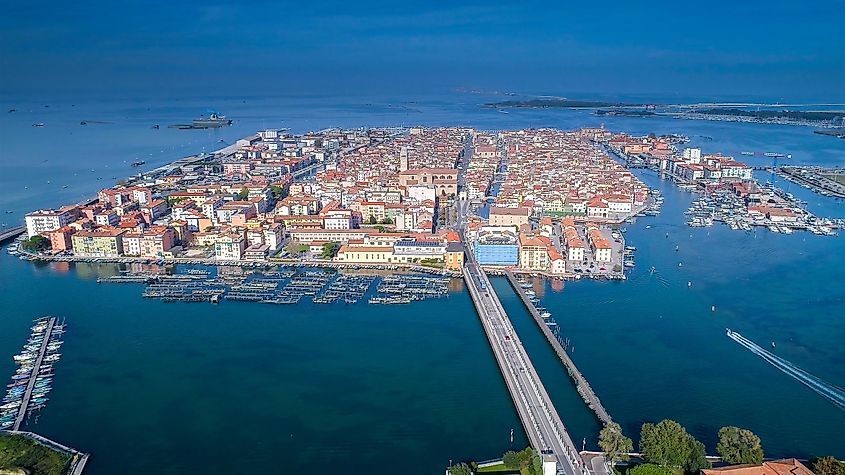
Gulf Of Venice
Also referred to as Golfo di Venezia in Italian, the Gulf of Venice is a gulf of the Adriatic Sea. Placed on the Adriatic Sea’s extreme northern end, the gulf is bounded by the easternmost point of Italy’s Po Delta on the southwest and by the southernmost point of Croatia’s Istrian Peninsula on the southeast. However, the Gulf of Venice is not officially recognized by the International Hydrographic Organization.
Geography Of The Gulf Of Venice

The Gulf of Venice is surrounded by the northeastern part of Italy and the southwestern parts of Slovenia and Croatia. As per informal definitions, the Gulf of Venice has a maximum width of about 75 miles and an average depth of about 125ft. Limited on all sides by the Adriatic Sea’s northern shore, the gulf is bounded on its southern side by an imaginary diagonal line between Maestra Point - the easternmost point of Northern Italy’s Po Delta and Cape Kamenjak – the southernmost point of Croatia’s Istrian Peninsula. Often, the northeastern end of the Gulf of Venice is informally named the Gulf of Trieste, which occupies an area of about 210 sq. mi and is defined as the portion of the Adriatic Sea placed to the northeast of an imaginary line between the southernmost point of Italy’s Punta Tagliamento and the westernmost point of Croatia’s Punta Salvore or Savudrija.

Some notable rivers that flow into the Gulf of Venice include the Adige, Brenta, Dragonja, Isonzo, Piave, and Tagliamento. The shores of the gulf are bordered by sandspits, marshes, and lagoons as far as the city of Trieste, which serves as the starting point of the low plateau of the Istrian Peninsula. Characterized by a highly dynamic frontal system, the Gulf of Venice separates the nutrient-rich and low-saline coastal riverine waters from the oligotrophic and comparatively more saline waters of the southern Adriatic Sea. The katabatic wind bora, which blows from the north to northeast direction, creates rough seas, leading to several shipping hazards in the Gulf of Venice.
History Of The Gulf Of Venice
The Venetian Republic was a sovereign state which existed for about 1100 years in portions of present-day northeastern Italy. During the Middle Ages, the republic started developing as a trading power, thanks to the maritime trading routes established by great navigators. The Venetian Gulf benefitted greatly due to the export and import of precious materials and the ability to build strong relationships with the Mediterranean and Far East countries. During Classical Antiquity, the gulf also served as the southern terminal of Amber Road, an ancient trading route used for transferring amber from the North Sea and Baltic Sea's coastal regions to the Mediterranean Sea.

Therefore, the rise of the Venetian Republic as a maritime power at the Gulf’s northwestern end increased the importance of the shipping routes of the Adriatic Sea. Eventually, the entire Adriatic Sea came to be known as the Gulf of Venice during the Renaissance and Early Italian History from 1559 to 1814. In due course, as the sea’s Latin name, ‘Mare Adriaticum,’ became more common among English and European geographers, the term ‘Gulf of Venice’ became restricted to the area around the city of Venice. In due course, Venice significantly prospered with the support of wealthy merchants who patronized the spectacular art and architecture along the city’s lagoons. However, the opening of new trading routes via the Atlantic Ocean to the Americas and the East Indies led to the decline of Venice as a prosperous maritime republic.
Places To Visit Around The Gulf

Some significant settlements along the Gulf are Chioggia, Koper, Adria, Pula, Trieste, and Venice. Located on a collection of 118 small islands that are separated by canals, Venice – the capital of the Veneto region, is a prosperous city in northeastern Italy. Renowned as a major cultural center with magnificent artworks and architecture, Venice is considered the most popular tourist destination. Apart from Venice, Pula and Trieste are the major modern ports along the Gulf of Venice.
There are several transition protected areas, including Sites of Community Importance (SCIs) and Special Areas of Conservation (SACs), both on the Gulf’s eastern and western sides. In order to preserve the gulf’s pristine biodiversity, several activities like oil and gas exploration, spilling of wastewater, and dumping of dredged materials are not permitted in these areas. The green Albarella Island, placed between the Adriatic Sea and the Po Delta lagoon, is one of the Adriatic coast’s most well-known tourist destinations. Located at the heart of the Po Delta Regional Park, this island is home to more than 150 different wild avian species, including the beautiful pink flamingos. The island also hosts a century-old fishing tradition dedicated to breeding mussels, clams, and the notable Delta oysters.
Despite standard protection measures, the Gulf of Venice, in recent times, has been severely impacted by anthropogenic activities like increased marine traffic, coastal and offshore aquaculture, and the discharge of pollutants via the rivers that drain into the gulf.











